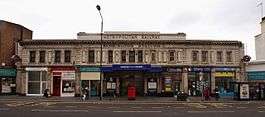London Paddington station
| Paddington | |
|---|---|
| London Paddington | |
|
The main Praed Street entrance and the Victorian train shed | |
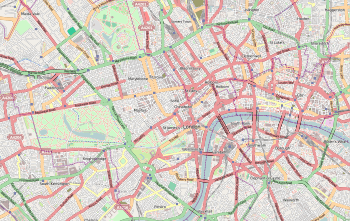 Paddington Location of Paddington in Central London | |
| Location | Paddington |
| Local authority | City of Westminster |
| Managed by | Network Rail |
| Station code | PAD |
| DfT category | A |
| Number of platforms | 14 |
| Accessible | Yes [1] |
| Fare zone | 1 |
| OSI |
Marylebone (National Rail) [2] Lancaster Gate (London Underground) |
| Cycle parking | Yes |
| Toilet facilities | Yes |
| National Rail annual entry and exit | |
| 2010–11 |
|
| 2011–12 |
|
| 2012–13 |
|
| 2013–14 |
|
| 2014–15 |
|
| Railway companies | |
| Original company | Great Western Railway |
| Key dates | |
| 4 June 1838 | Temporary station opened |
| 29 May 1854 | Permanent station opened |
| Other information | |
| Lists of stations | |
| External links | |
| WGS84 | 51°31′02″N 0°10′39″W / 51.5173°N 0.1774°WCoordinates: 51°31′02″N 0°10′39″W / 51.5173°N 0.1774°W |
|
| |
Paddington, also known as London Paddington, is a central London railway terminus and London Underground station complex, located on Praed Street in the Paddington area. The site has been the London terminus of the Great Western Railway and its successors since 1838. Much of the main-line station dates from 1854 and was designed by Isambard Kingdom Brunel. It was first served by London Underground trains in 1863, as the original western terminus of the Metropolitan Railway, the world's first underground railway. Today, Paddington tube station is served by the Bakerloo, Circle, District, and Hammersmith & City lines.
Paddington is the London terminus of the Great Western Main Line, operated today by Great Western Railway, which provides the majority of commuter and regional passenger services to west London and the Thames Valley region as well as long-distance intercity services to South West England and South Wales. It is also the terminus for the Heathrow Express and Heathrow Connect services to and from London Heathrow Airport. It is one of 19 stations in the United Kingdom managed directly by Network Rail. It is situated in fare zone 1.
Location
The station complex is bounded at the front by Praed Street and at the rear by Bishop's Bridge Road, which crosses the station throat on the recently replaced Bishop's Bridge. On the west side of the station is Eastbourne Terrace, while the east side is bounded by the Paddington arm of the Grand Union Canal. The station is in a shallow cutting, a fact obscured at the front by a hotel building, but which can be clearly seen from the other three sides.[4]
The surrounding area is partly residential, and includes the major St Mary's Hospital, restaurants and hotels. Until recently there was little office accommodation in the area, and most commuters interchanged between National Rail and the London Underground to reach workplaces in the West End or the City. However, recent redevelopment of derelict railway and canal land, marketed as Paddington Waterside, has resulted in new office complexes nearby.[4][5]
In addition to the Underground stations at Paddington, Lancaster Gate tube station on the Central line is a short walk away to the south. A little further to the south lie the conjoined parks of Hyde Park and Kensington Gardens.[6]
National Rail station
The National Rail station is officially named London Paddington, a name commonly used outside London but rarely by Londoners, who call it just Paddington, as on the London Underground map. Parts of the station, including the main train shed, date from 1854, when it was built by Isambard Kingdom Brunel as the London terminus for the Great Western Railway (GWR). It is one of 19 stations managed by Network Rail.[7]
History
The first station was a temporary terminus for the GWR on the west side of Bishop's Bridge Road, opened on 4 June 1838. The first GWR service from London to Taplow, near Maidenhead, ran from Paddington in 1838. After the main station opened in 1854, this became the site of the goods depot.[5][8]
_p140_-_Paddington_Station_(plan).jpg)
| London Paddington station | |||||||||||||||||||||||||||||||||||||||||||||||||||||||||||||||||||||||||||||||||||||||||||||||||||||||||||||
|---|---|---|---|---|---|---|---|---|---|---|---|---|---|---|---|---|---|---|---|---|---|---|---|---|---|---|---|---|---|---|---|---|---|---|---|---|---|---|---|---|---|---|---|---|---|---|---|---|---|---|---|---|---|---|---|---|---|---|---|---|---|---|---|---|---|---|---|---|---|---|---|---|---|---|---|---|---|---|---|---|---|---|---|---|---|---|---|---|---|---|---|---|---|---|---|---|---|---|---|---|---|---|---|---|---|---|---|---|---|
Legend | |||||||||||||||||||||||||||||||||||||||||||||||||||||||||||||||||||||||||||||||||||||||||||||||||||||||||||||
| |||||||||||||||||||||||||||||||||||||||||||||||||||||||||||||||||||||||||||||||||||||||||||||||||||||||||||||
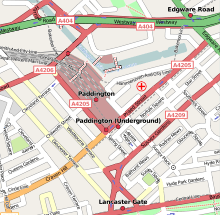

The main station between Bishops Bridge Road and Praed Street was designed by Brunel, who was commemorated by a statue on the concourse (since moved to Platform 1, by the exit to the former taxi rank), although much of the architectural detailing was by his associate Matthew Digby Wyatt. It opened on 29 May 1854. The glazed roof is supported by wrought iron arches in three spans, respectively spanning 68 feet (21 m), 102 feet (31 m) and 70 feet (21 m). The roof is 699 feet (210 m) long, and the original roof spans had two transepts connecting the three spans. It is commonly believed that these were provided by Brunel to accommodate traversers to carry coaches between the tracks within the station. However recent research, using early documents and photographs, does not seem to support this belief, and their actual purpose is unknown.[5][8][9]

The Great Western Hotel was built on Praed Street in front of the station in 1851–1854 by architect Philip Charles Hardwick, son of Philip Hardwick (designer of the Euston Arch). The station was substantially enlarged in 1906–1915 and a fourth span of 109 feet (33 m) was added on the north side, parallel to the others. The new span was built in a similar style to the original three spans, but the detailing is different and it has no transepts.[5][10]
On Armistice Day 1922, a memorial to the employees of the GWR who died during the First World War was unveiled by Viscount Churchill. The bronze memorial, depicting a soldier reading a letter, was sculpted by Charles Sargeant Jagger and stands on platform 1.[10][11]
A very early construction by Brunel was discovered immediately to the north of the station. A cast-iron bridge carrying the Bishop's Bridge Road over the Paddington Arm of the Grand Union Canal was uncovered after removal of brick cladding during the replacement of the adjacent bridge over the railway lines at the mouth of the station.[5]
The band Supertramp used the station to record the train sounds featured in the song "Rudy" on the 1974 album Crime of the Century.[12]
Accidents and incidents
- On 19 February 1840 a mail train was derailed near Paddington. There were no injuries.[13]
- On 15 November 1840, a rear end collision occurred between a passenger train and a light engine. Six passengers were injured.[14][15]
- On 21 July 1874, a passenger train was misrouted into a siding and collided with the buffer stop. Some passengers sustained slight injuries and shock.[16]
- On 9 August 1920, a passenger train collided with the buffers. Two people were injured.[17]
- On 12 September 1921, a passenger train was being shunted into a platform and collided with three luggage vans already occupying the line. A carriage was derailed and a luggage van was wrecked.[18]
- On 23 November 1983, a sleeper train hauled by Class 50 locomotive 50 041 Bulwark was derailed on the approach to Paddington due to excessive speed through a crossover. Three of the seventy passengers were injured.[19][20]
- On 25 May 2014, Class 360 electric multiple unit 360 205 derailed at it entered the station due to maintenance errors.[21]
- On 16 June 2016, Class 165 diesel multiple unit 165 124 was derailed near the station, causing significant disruption to services.[22]
Today
Paddington has 14 terminal platforms, numbered 1 to 14 from south-west to north-east (left to right as seen from the concourse). Platforms 1 to 8 are below the original three spans of Brunel's train shed, platforms 9 to 12 beneath the later fourth span. Platforms 13 and 14 are within the Metropolitan Railway's old Bishop's Road (Suburban) station to the north-west. Immediately alongside are through platforms 15 and 16, used by the London Underground's Hammersmith & City and Circle lines (see below).[23]
Platforms 6 and 7 are dedicated to the Heathrow Express, and platforms 13 and 14 can be used only by local services' Turbo trains up to seven cars long.[24] Platforms 1 to 5 and 8 to 12 can be used by any services, but long-distance trains generally use the south-western platforms, and local trains (including Heathrow Connect) the north-eastern ones.

The concourse stretches across the heads of platforms 1 to 12, underneath the London end of the four train sheds. Platforms 13 and 14 can only be reached indirectly via the north-western end of platform 12, or from the footbridge which crosses the north-western end of the station and gives access to all platforms.[23]
The area between the rear of the Great Western Hotel and the concourse is traditionally called The Lawn. It was originally unroofed and occupied by sidings, but was later built up to form part of the station's first concourse. The Lawn has recently been re-roofed and separated from the concourse by a glass screen wall. It is surrounded by shops and cafés on several levels.[5][10]
There are ticket barriers to platforms 2–5 and 10–16.[25]
The fourth span has been renovated, involving repair and restoration of the original glazed roof, so that platforms 9 to 12 inclusive can once more enjoy daylight.[26] A false ceiling or crash deck had been in place since 1996. Work was completed and the restored roof unveiled in July 2011. Network Rail originally planned to demolish Span 4 and build an office block over that part of the station; Save Britain's Heritage successfully campaigned against this.[27]
A first-class lounge on Platform 1 provides complimentary refreshments and Wi-Fi internet access. It also has screens showing television news as well as a departure board.[28]
Heathrow Express provides flight information display screens for airline passengers at the Heathrow Express ticket office near the dedicated Heathrow Express platforms 6 and 7.[29] Baggage check-in facilities for airline passengers were provided in 1999 in the Lawn but progressively replaced by retail units.[30]

Services
Paddington is the London terminus for long-distance high-speed trains operated by Great Western Railway. The most common destinations are:[31]
| Journeys in 2007/08 (million) | |
|---|---|
| Reading | 4.0 |
| Didcot Parkway | 1.1 |
| Swindon | 1.0 |
| Bristol Temple Meads | 0.9 |
| Bath Spa | 0.8 |
| Cardiff Central | 0.7 |
| Bristol Parkway | 0.6 |
| Newbury | 0.6 |
| Exeter St David's | 0.4 |
| Chippenham | 0.4 |
Other long-distance destinations are Taunton, Plymouth, Truro and Penzance in the West Country; Hereford and Worcester in the West Midlands; and Newport, Bridgend and Swansea in South Wales.
The current operator, Great Western Railway, assigns numbers to the pocket timetables it publishes, and its services to Bath, Bristol, Weston-super-Mare and South Wales are in timetable number 1.[32]
An integrated timetable is offered between Paddington and Rosslare Europort in Ireland via the Stena Line ferry from Fishguard Harbour railway station with through ticketing to stations in Ireland[33] and a daily morning and evening service in both directions, changing at Newport, Cardiff or Swansea. This route has been in existence since 1906.
Paddington is the terminus for suburban trains to West London and the Thames Valley, also operated by Great Western Railway. The most important destinations are:[34]
| Journeys in 2007/08 (million) | |
|---|---|
| Slough | 2.0 |
| Maidenhead | 1.6 |
| Oxford | 1.5 |
| Ealing Broadway | 1.0 |
| Hayes and Harlington | 1.0 |
| Newbury | 0.6 |
| West Drayton | 0.6 |
| West Ealing | 0.6 |
| Twyford | 0.5 |
| Windsor & Eton | 0.4 |
Note: These figures exclude Heathrow Express and some TfL Travelcard data
Other important short-distance services are Reading and Didcot Parkway. In 2010 Network Rail published a map showing the range and importance of destinations served, using 2006/07 data.[35]
Two services go to Heathrow Airport: the Heathrow Express travels non-stop at a premium fare, while Heathrow Connect takes the same route but calls at most intermediate stations.[36][37]
Paddington is an alternative London terminal for Chiltern Railways' service to Birmingham, used when London Marylebone is inaccessible for engineering or other reasons, and for one daily service (departs 11:36), towards West Ruislip, calling at South Ruislip. Virgin CrossCountry used to run services to Paddington from Glasgow Central and Blackpool North. These services were withdrawn in Summer 2003 as part of Virgin's Operation Princess.[38]
| Preceding station | |
Following station | ||
|---|---|---|---|---|
| Terminus | Great Western Railway Greenford Branch Line |
Acton Main Line | ||
| Terminus | Great Western Railway Great Western Main Line |
Slough or Reading | ||
| Terminus | Great Western Railway Night Riviera |
Reading | ||
| Terminus | Great Western Railway Commuter services Great Western Main Line |
Acton Main Line or Ealing Broadway | ||
| Terminus | Heathrow Connect Paddington – Heathrow |
Ealing Broadway | ||
| Terminus | Chiltern Railways Acton to Northolt Line (Limited Services) Monday-Friday Only |
South Ruislip | ||
| Heathrow Express | ||||
| Terminus | Heathrow Express London Paddington–Heathrow Airport |
Heathrow Central | ||
London Underground stations
| Paddington | |
|---|---|
|
Entrance on Praed Street | |
| Location | Paddington |
| Local authority | City of Westminster |
| Managed by | London Underground |
| Number of platforms | 6 |
| Accessible | Yes (Circle and H&C lines only and Circle and District lines westbound only)[39] |
| Fare zone | 1 |
| OSI |
Marylebone NR [2] Lancaster Gate |
| London Underground annual entry and exit | |
| 2012 |
|
| 2013 |
|
| 2014 |
|
| 2015 |
|
| Key dates | |
| 1863 | Opened (MR, as terminus) |
| 1864 | Extension (MR, to Hammersmith) |
| 1868 | Opened (MR, to Gloucester Rd) |
| 1913 | Opened (Bakerloo, as terminus) |
| 1915 | Extension (Bakerloo line) |
| 1926 | Started (District line) |
| 1949 | Started (Circle line) |
| 1990 | Started (Hammersmith & City) |
| 2009 | Extension (Circle line to Hammersmith) |
| Listed status | |
| Listed feature | Circle and District line Station |
| Listing grade | II |
| Entry number | 1392020[41] |
| Added to list | 11 August 2003 |
| Other information | |
| Lists of stations | |
|
| |
Paddington is served by four London Underground lines through two separate stations: the Bakerloo, Circle and District lines have a combined sub-surface and deep-level station to the south of the main-line station, and the Hammersmith & City and Circle lines have a sub-surface station to the north. Circle line services go through both of the sub-surface stations as part of a spiral route. Although shown on the London Underground map as a single station,[42] the two sub-surface parts are not directly linked.
Although Paddington is not served by the Central line, the short walk to Lancaster Gate tube station is taken by many commuters heading for the West End or the City, as it can be quicker than alternative routes.
History
The first underground railway station was opened as Paddington (Bishop's Road) by the Metropolitan Railway (MR) on 10 January 1863 as the terminus of the line from Farringdon. The station was to the north of the main-line station and, from 13 June 1864, MR services were extended westward via a connection to the GWR's Hammersmith branch, now the Hammersmith & City line.[43]
On 1 October 1868, the MR opened a branch to Gloucester Road, with a station called Paddington (Praed Street) in a cut-and-cover tunnel parallel to that street south of the main-line station. The deep-level Baker Street and Waterloo Railway (now the Bakerloo line) station opened on 1 December 1913 as a temporary terminus of an extension from Edgware Road to Queen's Park.[43]
Services on what became the Circle line in 1949 were originally shared by the MR and the District Railway. Hammersmith & City line services were originally operated as part of the MR (later the Metropolitan line) and were separately identified as the Hammersmith & City line in 1990.[43]
From December 2009, the Circle line was altered so that trains run in a spiral from Hammersmith via Ladbroke Grove to the Bishops Road platforms at Paddington, then on to Edgware Road, Kings Cross, Tower Hill, Victoria, High Street Kensington and back to Edgware Road via the Praed Street platforms at Paddington.[44] This means that eastbound trains from the District and Circle line platforms all terminate at Edgware Road, the next station. Passengers for stations beyond Edgware Road either have to change there, or use services from the Hammersmith & City line platforms. All trains towards King's Cross now leave from the same platform, instead of being split between two platforms some distance apart.
The platforms of the Hammersmith & City and Circle lines (Bishop's Road) station are still separate from the other Underground platforms; they are numbered 15 and 16, in the same sequence as the main-line platforms. Interchange between the Bakerloo line's and the District/Circle lines' platforms, and the Hammersmith & City and Circle lines' platforms, involves walking the length of the main-line station outside the Underground barrier lines, although the ticket barriers are programmed to permit changing between the two stations as part of a single journey.
Services
Hammersmith & City line trains run between Hammersmith and Barking via Paddington (Suburban) platforms 15 and 16. Circle line trains share tracks with the Hammersmith & City line from Hammersmith to Liverpool Street, then around a clockwise loop via Aldgate and Victoria, arriving back at Paddington (Praed Street), before terminating at Edgware Road. District line services run between Wimbledon and Edgware Road, and Bakerloo line trains run between Elephant & Castle and Harrow & Wealdstone stations.[42] Between 2 April 2016 until 1 August 2016, the Bakerloo platform was closed and all Bakerloo trains bypassed the station in order to prepare for the forthcoming Crossrail line. [45]
| Paddington (Praed Street) | ||||
| Preceding station | Following station | |||
|---|---|---|---|---|
towards Harrow & Wealdstone | Bakerloo line | Deep tube station towards Elephant & Castle |
||
| Circle line | Subsurface station Terminus |
|||
towards Wimbledon | District line Wimbledon-Edgware Road | |||
| Paddington (Suburban) | ||||
| Preceding station | Following station | |||
towards Hammersmith | Circle line | Subsurface station |
||
| Hammersmith & City line | Subsurface station towards Barking |
|||
Crossrail station
A Crossrail station for Paddington is being built under Eastbourne Terrace, the road alongside the south-west side of the main-line station, and also under the adjacent taxi rank in the Departures Road (so called, because it served what was originally the departures side of the station). Eastbourne Terrace was closed for about two years from 12 February 2012. A new taxi rank is on the other side of the station, above Platform 12. Crossrail services are due to start in 2018.[46] The new station box will be 23 metres deep and 260 metres long.[47]
| Preceding station | Following station | |||
|---|---|---|---|---|
towards Reading | Crossrail Elizabeth line | towards Shenfield |
||
towards Heathrow Terminal 4 | Crossrail Elizabeth line | towards Abbey Wood |
In fiction
The mystery novel 4.50 From Paddington (1952) by Agatha Christie begins with a murder witnessed by a passenger on a train from Paddington.[48]
One of The Railway Series books, The Eight Famous Engines, contains a story about Gordon, Duck and a foreign engine debating which station London is. Duck says that he used to work at Paddington as a station pilot so he thinks Paddington is most important. However, Gordon later finds out that the station in London is St Pancras.

The children's book character Paddington Bear was named after the station. In the books, by Michael Bond, he is found at the station, having come from "deepest, darkest Peru" and with a note attached to his coat reading "please look after this bear, thank you". A statue of him by Marcus Cornish, based on the original drawings by Peggy Fortnum, is located under the clock on platform 1.[49][50][51]
There is a fictional underground Paddington station on the North London System in the novel The Horn of Mortal Danger (1980).[52]
In the Sherlock episode The Hounds of Baskerville, Sherlock Holmes and Dr Watson go to Paddington to get to Dartmoor for a case. In the novel The Hound of the Baskervilles, Watson and his companions Dr. Mortimer and Sir Henry Baskerville leave for Dartmoor from Paddington.
Connections
London Buses routes 7, 23, 27, 36, 46, 205, 332 and 436 and night route N7 and N205 serve the station.
Gallery
-
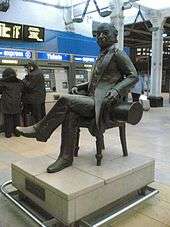
Statue of Isambard Kingdom Brunel.
-

The Station Clock
-
Platforms 1, 2 and 3 with First Great Western trains for the West of England and Wales.
-
First Great Western (local) and Heathrow Connect trains pass on the approach of Paddington.
-

London Street entrance.
-
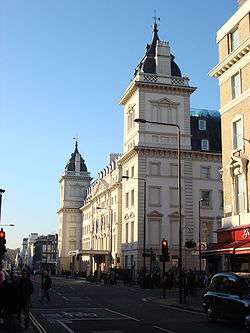
Hilton London Paddington.
-

The concourse is traditionally known as the Lawn.
-

Complimentary refreshments in the first class lounge.
-

Pannier tank on empty stock working in 1962
-

Empty stock arriving in 1962
-
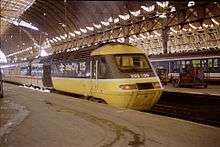
InterCity 125 at Platform 1 in 1988
References
- ↑ "London and South East" (PDF). National Rail Enquiries. National Rail. September 2006. Archived from the original (pdf) on 6 March 2009.
- 1 2 "Out of Station Interchanges" (XLS). Transport for London. May 2011. Archived from the original on 20 October 2012.
- 1 2 3 4 5 "Station usage estimates". Rail statistics. Office of Rail Regulation. Please note: Some methodology may vary year on year.
- 1 2 "Paddington Station Planning Brief" (PDF). Westminster City Council. April 2009. Retrieved 28 July 2008.
- 1 2 3 4 5 6 Brindle, Steven (2004). Paddington Station: Its History and Architecture. English Heritage. ISBN 1-873592-70-1.
- ↑ "Lancaster Gate Tube Station". LondonTown.com. Retrieved 21 April 2015.
- ↑ "Commercial information". Our Stations. London: Network Rail. April 2014. Retrieved 12 April 2014.
- 1 2 Butt, R.V.J. (1995). The Directory of Railway Stations. Yeovil: Patrick Stephens. p. 180. ISBN 1-85260-508-1. R508.
- ↑ Cole, Beverly (2011). Trains. Potsdam, Germany: H.F.Ullmann. p. 104. ISBN 978-3-8480-0516-1.
- 1 2 3 "Architectural mini guide – Paddington" (PDF). Network Rail. Archived from the original (PDF) on 10 September 2012. Retrieved 19 February 2015.
- ↑ "Great Western Railway War Memorial". The Great Western Railway Magazine. December 1922. pp. 537–40. Retrieved 9 July 2007.
- ↑ The Mojo Collection. Canongate. November 2007. p. 335. Retrieved 17 December 2011.
- ↑ "Great Western Railway". The Standard (4989). London. 20 February 1840.
- ↑ "Railway Accidents". The Times (17519). London. 15 November 1840. col D, p. 6.
- ↑ "Accident at Paddington on 15th November 1840". Railways Archive. Retrieved 17 June 2016.
- ↑ "Summary of this Morning's News". The Pall Mall Gazette (2942). London. 22 July 1874.
- ↑ "Train Accident at Paddington". The Times (42485). London. 10 August 1870. col E, p. 7.
- ↑ "Collision at Paddington Station". The Times (42824). London. 13 September 1921. col D, p. 7.
- ↑ "Eleven coaches derailed in Paddington sleeper crash". The Times (61698). London. 24 November 1983. col B-F, p. 32.
- ↑ Department of Transport (18 February 1985). "Report of the derailment that occurred on 23rd November 1983 at Paddington Station" (PDF). Her Majesty's Stationary Office. ISBN 0 11 550686 1. Retrieved 18 June 2016.
- ↑ "Derailment of an empty passenger train at Paddington station 25 May 2014" (PDF). Rail Accidents Investigation Branch. Retrieved 17 June 2016.
- ↑ "Train derails at Paddington: Services disrupted in and out of station". BBC News Online. 16 June 2016. Retrieved 17 June 2016.
- 1 2 "Paddington – Station Guide" (PDF). Network Rail. Retrieved 30 July 2008.
- ↑ Yonge, John; Padgett, David (August 2010) [1989]. Bridge, Mike, ed. Railway Track Diagrams 3: Western (5th ed.). Bradford on Avon: Trackmaps. map 1A. ISBN 978-0-9549866-6-7.
- ↑ "Paddington getting ticket gates". London Connections blog. 7 April 2008.
- ↑ "Let there be light". Railnews. Stevenage. Retrieved 16 August 2011.
- ↑ "Victory at Paddington" (PDF). Save Britain's Heritage. 16 November 2006. Retrieved 14 February 2012.
- ↑ "First Class". First Great Western. Retrieved 6 May 2015.
- ↑ "Heathrow Express brings back Check-in to reduce passenger stress". AirRailNews. 1 December 2009. Retrieved 15 February 2012.
- ↑ Sharp, Andrew W. (5 November 2004). "Processing of airline passengers and their baggage at off-airport bus, water and rail terminals – successful intermodal terminals" (PDF). International Air Rail Organisation. Retrieved 15 February 2012.
- ↑ "Great Western Route Utilisation Study" (PDF). Figure 3.10. Network Rail. March 2010. Retrieved 14 February 2012.
- ↑ "Current timetable". Retrieved 4 August 2012.
- ↑ "Rosslare to Fishguard". Stena Line. n.d. Retrieved 8 March 2013.
- ↑ "Great Western Route Utilisation Study" (PDF). Figure 3.12. Network Rail. March 2010. Retrieved 14 February 2012.
- ↑ "Key Flows to/from London Paddington" (PDF). Network Rail. March 2010. Retrieved 4 August 2012.
- ↑ "Our Company". Heathrow Express. Retrieved 2 August 2008.
- ↑ "Welcome". Heathrow Connect. Retrieved 2 August 2008.
- ↑ VT3 timetable 2003
- ↑ "Step free Tube Guide" (PDF). Transport for London. Archived (PDF) from the original on 3 June 2015.
- 1 2 3 4 "Multi-year station entry-and-exit figures" (XLS). London Underground station passenger usage data. Transport for London. April 2016. Retrieved 3 May 2016.
- ↑ Historic England. "Paddington, District and Circle Line Underground Station (1392020)". National Heritage List for England. Retrieved 3 April 2015.
- 1 2 "Standard Tube Map" (PDF). Transport for London. December 2009. Retrieved 23 December 2009.
- 1 2 3 Rose, Douglas (1999) [1980]. The London Underground, A Diagrammatic History. Douglas Rose/Capital Transport. ISBN 1-85414-219-4.
- ↑ Hoscik, Martin (6 March 2009). "Circle line extended to Hammersmith". Mayorwatch. Retrieved 26 March 2013.
- ↑ "Major improvement works at Paddington paves the way for Crossrail". Transport for London. Retrieved 19 May 2016.
- ↑ "Changes to travel around Paddington Station due to Crossrail works" (Press release). Transport for London. 10 February 2012. Retrieved 14 February 2012.
- ↑ "Paddington Crossrail contract signed". Rail. Peterborough. 10 August 2011. p. 21.
- ↑ Christie, Agatha (1957). 4.50 From Paddington. Harper Collins. ISBN 978-0-00-720854-8.
- ↑ McSmith, Andy (24 May 2008). "Paddington returns to his station as children's favourite". The Independent.
- ↑ Silvey, Anita (2002). The Essential Guide to Children's Books and Their Creators. Houghton Mifflin. p. 51. ISBN 0-618-19082-1.
- ↑ "Statues of Fictional Characters". Secret London. Retrieved 21 April 2015.
- ↑ Leonard, Lawrence (1980). The Horn of Mortal Danger. Cox and Wyman. ISBN 0-7445-0847-9.
Further reading
External links
| Wikimedia Commons has media related to Paddington station. |
- Station information on Paddington station from Network Rail
- Train times and station information for Paddington railway station from National Rail (Station code: PAD)
- Paddington Station (Virtual Archive from Network Rail)

